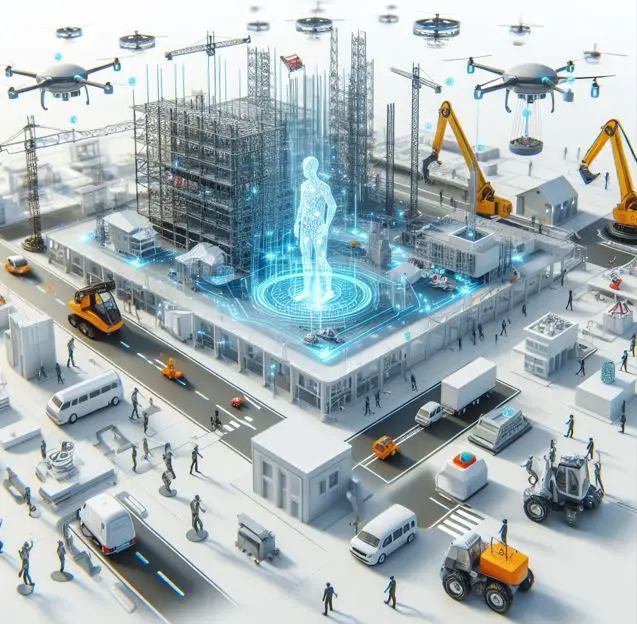As we stand on the brink of 2024, the construction industry, one of the oldest and most vital sectors of our economy, is on the cusp of a revolutionary transformation. The catalyst of this transformation? Artificial Intelligence (AI). Historically, construction has been perceived as a sector slow to adopt new technologies. However, the winds of change are blowing, and they are powered by AI.
Imagine a construction site in 2049. It’s a hive of activity, but not in the way we know it today. Drones buzz overhead, scanning the site and feeding data back to AI algorithms. These algorithms, in turn, predict potential structural issues, optimize resource allocation, and ensure that every brick laid is a step toward a structure that is not only physically sound but also environmentally friendly and economically viable.
This article delves deep into this future, exploring how construction AI is poised to redefine the construction landscape. From transforming roles to introducing groundbreaking technologies, enhancing safety protocols, and navigating the ethical implications of such a profound integration, we’re embarking on a journey to uncover the future of construction in an AI-driven world.
How might our roles in the construction industry change?
In the shadows of towering cranes and amidst the rhythmic hum of machinery, a new revolution is quietly unfolding in the construction industry. This revolution is not marked by the clang of hammers, but by the soft whir of processors and the glow of screens. Artificial Intelligence (AI) is reshaping the very fabric of construction roles, enhancing human capabilities, and opening new frontiers of innovation.
AI in construction goes beyond mere automation; it’s about augmentation. The construction worker of 2049 is a technologically empowered individual, equipped with smart helmets and AR displays, seamlessly integrating digital information with the physical world. These futuristic builders don’t just follow blueprints; they interact with holographic projections, adjust plans in real-time, and make data-driven decisions that optimize both the process and the product.
Project managers, too, are evolving into orchestrators of efficiency. AI provides them with real-time insights into every aspect of the project, from the supply chain logistics to the minute-to-minute progress on site. Predictive algorithms help in preempting delays, managing risks, and ensuring that the project stays on track, both timewise and financially.
Even safety officers are now guardians of a safer and more secure work environment, backed by AI’s vigilant eye. Automated drones monitor the site, identifying potential hazards and ensuring compliance with safety protocols. In this AI-augmented realm, the focus is on preventing accidents before they occur, ensuring that every worker returns home safe.
As we delve deeper into the future, one thing becomes clear: AI doesn’t spell the obsolescence of the human worker. Instead, it heralds a new age of collaboration between human intellect and artificial intelligence, a synergy where each complements the other, driving the construction industry towards unprecedented heights of efficiency, safety, and innovation.
Emerging AI Technologies in Construction
As we venture into the future of construction, emerging AI technologies are not just reshaping the landscape; they’re redefining the very essence of project management, design, and execution. Companies like Civils.ai, nPlan, AI Clearing, CerebrumX, Wint, Saifety.ai, and OpenSpace are at the forefront of this revolution, each contributing a unique thread to the tapestry of an AI-integrated construction industry.
Singapore-based Civils.ai is a testament to how AI can streamline operations and enhance efficiency. As a SaaS tool utilizing a large language model, Civils.ai drastically reduces the time required to search through construction project documents. By processing information from various PDF documents, it enables users to extract precise answers to project-related queries swiftly.
The tool, using technology akin to that powering ChatGPT, has been fine-tuned specifically for the construction industry, transforming complex reports and data into a comprehensible format. The addition of geological data to create simulated environments marks a leap towards a future where project planning and execution are not just envisioned but virtually experienced and perfected.
AI Clearing, with its roots in Poland and operations in Austin, Texas, harnesses data from drones and on-site workers to provide a real-time snapshot of project progress. The integration with Oracle’s suite of products signifies a leap towards seamless project management, where discrepancies and delays are not just identified but preemptively addressed, ensuring that every cubic meter of concrete poured is a step in the right direction.
Michigan-based CerebrumX leverages real-time data from an expansive fleet of vehicles to redefine fleet management and maintenance. The platform’s ability to integrate data from modern and legacy systems alike offers a comprehensive overview of vehicle health and performance, paving the way for a future where fleet management is not just about maintenance but about proactive care and optimal operational efficiency.
Wint, hailing from Israel, employs AI to address one of the most pressing concerns in construction – water management. The AI-enabled system not only detects anomalies in water usage but takes decisive action, preventing potential damage and ensuring that resource management is not just a practice but a proactive, intelligent operation.
Lastly, OpenSpace.ai from California brings a digital dimension to physical construction sites. By digitizing real-life images and aligning them with digital models, OpenSpace offers a panoramic view of project progress, ensuring that the blueprint of a structure is not just a plan but a living, evolving narrative.
In the grand canvas of construction’s future, these companies and their AI-driven solutions represent not just technological advancements but a shift towards a more informed, efficient, and conscientious industry. The potential of AI in construction is not just in the automation of tasks but in the creation of a synergistic ecosystem where every stakeholder, every machine, and every data point is interconnected, driving the industry towards a future built on precision, foresight, and innovation.
Challenges and Limitations in AI Adoption
While the integration of AI in the construction industry heralds a future filled with promise and potential, it’s not without its set of challenges and limitations. As the industry navigates through this technological transformation, it’s crucial to acknowledge and address these hurdles to harness AI’s full potential effectively.
One of the primary challenges lies in the realm of data. AI systems thrive on data, but the construction industry, traditionally cautious in its adoption of digital technologies, often grapples with fragmented and unstructured data. The lack of standardized, high-quality data can impede the efficiency and accuracy of AI algorithms. Establishing robust data governance and investing in data standardization are imperative steps in overcoming this challenge.
Another significant hurdle is the integration of AI into existing workflows. Construction projects involve a myriad of stakeholders, each with their specialized processes and systems. Seamlessly integrating AI into these complex workflows requires not just technological solutions but also a change in mindset, fostering a culture of innovation and openness to change.
Furthermore, the issue of cybersecurity looms large. As construction sites become more connected and reliant on AI, they become more vulnerable to cyber threats. Protecting sensitive data and ensuring the integrity of AI systems is paramount, necessitating stringent cybersecurity measures and constant vigilance.
The workforce, too, faces a pivotal challenge. The introduction of AI in construction necessitates a shift in skills. Workers need to be upskilled or reskilled to thrive in this new environment, where familiarity with digital tools and AI becomes as fundamental as traditional construction skills. This transition requires comprehensive training programs and a commitment to lifelong learning.
Lastly, the high initial cost of implementing AI technologies can be a barrier, especially for smaller firms. However, this investment is not just a cost but a leap into the future—a future where the returns, in terms of efficiency, safety, and sustainability, far outweigh the initial expenditure.
In addressing these challenges, the construction industry is not just preparing to integrate AI; it’s gearing up to redefine itself, emerging stronger, smarter, and more resilient.
Ethical Considerations in AI Deployment
As the construction industry embraces AI, it’s imperative to navigate this new frontier with a compass pointed firmly towards ethical considerations. The integration of AI brings not just opportunities for growth and advancement but also a profound responsibility to ensure that this powerful technology is used in a manner that is responsible, transparent, and equitable.
Transparency is the cornerstone of ethical AI deployment. It’s crucial for AI systems to be transparent in their operations, enabling stakeholders to understand how decisions are made and ensuring that there’s a clear audit trail. This transparency extends to data handling practices, ensuring that all stakeholders are aware of how their data is used and that their privacy is protected.
Data privacy is another paramount concern. As construction sites become data-rich environments, safeguarding this data against breaches and ensuring it’s used in compliance with regulations and ethical standards is vital. This involves implementing robust cybersecurity measures and adhering to strict data governance policies.
Bias in AI is a challenge that transcends industries, and construction is no exception. Ensuring that AI systems are free from bias and offer equal opportunities to all is a moral imperative. This involves careful design and continuous monitoring of AI systems to ensure that they make decisions based on relevant criteria, free from discriminatory biases.
Moreover, the ethical deployment of AI in construction also means considering the impact on the workforce. It involves ensuring that the transition to a more AI-integrated workplace is just and inclusive, offering training and reskilling opportunities to workers and maintaining a human-centric approach to technology adoption.
In this journey towards an AI-driven future, the construction industry has the opportunity to set a benchmark for ethical AI deployment. By prioritizing transparency, data privacy, bias mitigation, and workforce welfare, the industry can ensure that the foundations it lays are not just physical structures but also the pillars of trust, integrity, and ethical progress.
Conclusion
As we stand on the threshold of 2049, the silhouette of the construction industry is being redrawn by the invisible hands of Artificial Intelligence. The journey we’ve embarked upon is not just about integrating technology into brick and mortar; it’s about reimagining the very ethos of construction. It’s about building not just structures, but a legacy of innovation, safety, and sustainability.
The construction industry, with its rich heritage and foundational significance, is on the cusp of a new era. An era where AI is not a distant dream but an integral part of every nail driven and every beam placed. This journey, however, is not without its challenges. It requires a steadfast commitment to ethical standards, a dedication to continual learning and adaptation, and a resolve to navigate the complexities of this technological integration with a clear vision and a steady hand.
As we peer into the future, the potential of AI in construction unfurls before us, limitless and brimming with possibilities. It beckons us to build not just with concrete and steel, but with data and algorithms, to construct not just edifices, but ecosystems of efficiency, safety, and harmony.
‘Construction 2049 – A Prediction into the Future of AI in Construction’ is not just a forecast; it’s a call to action. It’s an invitation to the industry to embrace this technological revolution, to wield the tools of AI not just with intelligence, but with wisdom, integrity, and a vision that transcends the horizon. For in this union of technology and tenacity, lies the blueprint of the future—a future constructed with the bricks of innovation and the mortar of human ingenuity.










